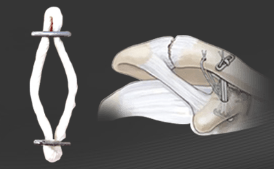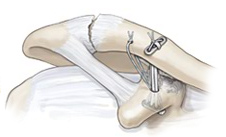
AC Joint Surgery Success Rate is Better with the Closed Loop Double Endobutton Procedure
With approximately 60,000 new AC Joint Separation cases (Grade 3, 4, or 5) a year, the question arises, “What is the success rate for an AC Joint surgery?”
There are several factors that need to be taken into consideration in order to answer that question:
- Was there early intervention?
- Will the AC Joint Surgery result in the natural movement of the shoulder?
- What AC Joint surgery technique is being used?
- Is the success rate based on factual evidence?
- Success rate over the long term
Advantage of Early Intervention
Early intervention for an ac joint separation is extremely beneficial, since no graft is needed. This means that it will be a repair and not reconstruction; leading to better results and success rate.
Will the AC Joint Surgery result in the Natural Movement of the Shoulder?
The natural movement of the shoulder and ac joint is more complex than a traditional two-dimensional x-ray shows us, since the joint motion moves in 3 planes (protraction/retraction, abduction/adduction, and anterior/posterior tilt).
Traditional surgeries typically cannot withstand the everyday movement of the shoulder and ac joint, and this results in limiting widespread acceptance of surgeries. Therefore, some doctors take a “wait and see” approach. “It is very common to be advised to adopt a ‘wait and see’ approach. This stance will likely turn an acute injury into a chronic deformity. The patient will then be requiring reconstruction, most likely with a graft, and with most certainly inferior outcomes”, explains Dr. Steven Struhl.
It is critical to have a thorough evaluation by an AC Joint Separation Specialist using digital analyses of x-rays for both the normal and abnormal sides to accurately determine the AC joint injury grade. Knowing the ac joint separation grade and appropriate procedure will lead to better results leading to the natural movement of the shoulder and ac joint.
AC Joint Surgery Techniques
Suture-Button configuration prone to knot slippage and breakage
Previous studies have shown that suture-button configurations that require a knot have poor results as a long-term solution. In fact, studies have shown that this method experiences slippage in 31% to 50% of the cases, as well as surgical complication rates of 27% to 52%.
New technique for fixation reduces knot slippage

Due to these unsatisfactory results, Dr. Steven Struhl, a leading Orthopedic Shoulder Specialist, and his team began research to find a solution where consistent long-term success without slippage for both acute and chronic ac joint dislocations could be achieved by combining a comprehensive soft tissue repair with a continuous loop procedure.
Dr. Struhl explains, “The surgical design was to use a continuous loop to eliminate knot breakage and slippage, is in line with biomechanical principles and always creates a biologic connection between the coracoid and the clavicle. The technique is open, the joint is reduced, a hole is drilled, the channel length is measured and the appropriate loop size is chosen and prepared with sutures. When the measured channel is within 1mm, a standard endobutton is used. When the measurement is in between, a larger loop is chosen, which leaves excess loop that is filled with an extended button that is thicker and wider and compensates for the extra loop.”
In 2012, a U.S. patent was awarded to Dr. Steven Struhl for his “Closed-Loop Double Endobutton” or “Continuous Loop” to repair an AC Joint Separation.
AC Joint Surgery Success Rate based on Factual Evidence
Dr. Steven Struhl conducted an 11-year study on the success rate of his “Closed Loop Double Endobutton” technique to repair an AC Joint Separation, and it was published in The American Journal of Sports Medicine. The study reveals that his “Continuous Loop” procedure has better results than tendon grafting and suture-button techniques, as well as other traditional methods for an AC Joint Separation. This study demonstrated that the use of a continuous loop design, significantly improved outcomes over standard suture-button configurations. Results proved that the “closed-loop” eliminates the problem of knot slippage or breakage that is inherent to a standard suture-button device. More importantly the loop has similar stiffness and more than double the strength of one’s own ligament. The “loop” was found to be durable and reliable, showed effective healing, and large load-bearing grafts were avoided.
Study Group with comprehensive evaluations
The study group consisted of 35 patients, who were followed for 4 to 11 years. Industry best practices of outcome scoring systems were used to validate results. For each patient, X-rays were done and quantitated comparing normal with the operative side. Follow-up information was obtained on all 35 patients and comprehensive evaluations were performed on 31.
At follow up, the average constant score was 98 (0-100), the mean University of California, Los Angeles Shoulder Rating Scale score was 34 (0-35), the mean American Shoulder and Elbow Surgeons Shoulder Score (ASES) was 98 (0-100) and the Simple Shoulder Test (SST) score was 11.3 (0-12). The average amount of “slippage” was only 1.2 mm, which is well below the clinical failure rate of 3 mm.
Success Rate over the Long Term
There was no tendency for loss of reduction over the 11-year period. Cosmetic appearance of both the incision and the shoulder was quite good. One patient did re-dislocate after an acute trauma; there was one asymptomatic late fracture and one patient required a late distal clavicle excision for pain. Follow-up MRI evaluation was performed on 10 patients, which confirmed a robust healing response.
Why does the Double Endobutton Continuous Loop have a better success rate?
- It has a strong and durable fixation
- Allows for normal physiologic movement of the shoulder and ac joint
- Surgeon friendly that minimizes complication risk and plan for long-term biologic stability.
The factual evidence shows that Dr. Steven Struhl’s Double Endobutton Continuous Loop procedure has a better success rate for an AC Joint Separation for the long term compared to other procedures.
Posted on behalf of Steven Struhl MD




